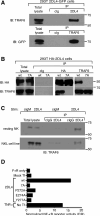TNFR-associated factor 6 and TGF-β-activated kinase 1 control signals for a senescence response by an endosomal NK cell receptor
- PMID: 24337384
- PMCID: PMC4556140
- DOI: 10.4049/jimmunol.1302384
TNFR-associated factor 6 and TGF-β-activated kinase 1 control signals for a senescence response by an endosomal NK cell receptor
Abstract
The endosomal innate receptor CD158d (killer cell Ig-like receptor 2DL4) induces cellular senescence in human NK cells in response to soluble ligand (HLA-G or agonist Ab). These senescent NK cells display a senescence-associated secretory phenotype, and their secretome promotes vascular remodeling and angiogenesis. To understand how CD158d initiates signaling for a senescence response, we mapped the region in its cytoplasmic tail that controls signaling. We identified a conserved TNFR-associated factor 6 (TRAF6) binding motif, which was required for CD158d-induced NF-κB activation and IL-8 secretion, TRAF6 association with CD158d, and TRAF6 recruitment to CD158d(+) endosomes in transfected cells. The adaptor TRAF6 is known to couple proximal signals from receptors such as endosomal TLRs and CD40 through the kinase TGF-β-activated kinase 1 (TAK1) for NF-κB-dependent proinflammatory responses. Small interfering RNA-mediated silencing of TRAF6 and TAK1, and inhibition of TAK1 blocked CD158d-dependent IL-8 secretion. Stimulation of primary, resting NK cells with soluble Ab to CD158d induced TRAF6 association with CD158d, induced TAK1 phosphorylation, and inhibition of TAK1 blocked the CD158d-dependent reprogramming of NK cells that produces the senescence-associated secretory phenotype signature. Our results reveal that a prototypic TLR and TNFR signaling pathway is used by a killer cell Ig-like receptor that promotes secretion of proinflammatory and proangiogenic mediators as part of a unique senescence phenotype in NK cells.
Figures





Similar articles
-
Cellular senescence induced by CD158d reprograms natural killer cells to promote vascular remodeling.Proc Natl Acad Sci U S A. 2012 Dec 11;109(50):20596-601. doi: 10.1073/pnas.1208248109. Epub 2012 Nov 26. Proc Natl Acad Sci U S A. 2012. PMID: 23184984 Free PMC article.
-
DNA-PKcs controls an endosomal signaling pathway for a proinflammatory response by natural killer cells.Sci Signal. 2010 Feb 23;3(110):ra14. doi: 10.1126/scisignal.2000467. Sci Signal. 2010. PMID: 20179272 Free PMC article.
-
TAK1-ECSIT-TRAF6 complex plays a key role in the TLR4 signal to activate NF-κB.J Biol Chem. 2014 Dec 19;289(51):35205-14. doi: 10.1074/jbc.M114.597187. Epub 2014 Nov 4. J Biol Chem. 2014. PMID: 25371197 Free PMC article.
-
Phosphoinositide-dependent kinase-1 inhibits TRAF6 ubiquitination by interrupting the formation of TAK1-TAB2 complex in TLR4 signaling.Cell Signal. 2015 Dec;27(12):2524-33. doi: 10.1016/j.cellsig.2015.09.018. Epub 2015 Sep 30. Cell Signal. 2015. PMID: 26432169
-
Endosomal signaling and a novel pathway defined by the natural killer receptor KIR2DL4 (CD158d).Traffic. 2010 Nov;11(11):1381-90. doi: 10.1111/j.1600-0854.2010.01112.x. Epub 2010 Sep 20. Traffic. 2010. PMID: 20854369 Review.
Cited by
-
miR-126-5p expression in the plasma of patients with sepsis-induced acute lung injury and its correlation with inflammation and immune function.Clin Respir J. 2023 Jul;17(7):629-637. doi: 10.1111/crj.13646. Epub 2023 May 29. Clin Respir J. 2023. PMID: 37248197 Free PMC article.
-
Regulation of toll-like receptor (TLR) signaling pathways in atherosclerosis: from mechanisms to targeted therapeutics.Acta Pharmacol Sin. 2023 Dec;44(12):2358-2375. doi: 10.1038/s41401-023-01123-5. Epub 2023 Aug 7. Acta Pharmacol Sin. 2023. PMID: 37550526 Free PMC article. Review.
-
Immunosuppressive network promotes immunosenescence associated with aging and chronic inflammatory conditions.J Mol Med (Berl). 2021 Nov;99(11):1553-1569. doi: 10.1007/s00109-021-02123-w. Epub 2021 Aug 25. J Mol Med (Berl). 2021. PMID: 34432073 Free PMC article. Review.
-
PTPN2 targets TAK1 for dephosphorylation to improve cellular senescence and promote adipose tissue browning in T2DM.Front Pharmacol. 2023 May 12;14:1124633. doi: 10.3389/fphar.2023.1124633. eCollection 2023. Front Pharmacol. 2023. PMID: 37251330 Free PMC article.
-
Cellular Senescence in Immunity against Infections.Int J Mol Sci. 2022 Oct 6;23(19):11845. doi: 10.3390/ijms231911845. Int J Mol Sci. 2022. PMID: 36233146 Free PMC article. Review.
References
Publication types
MeSH terms
Substances
Grants and funding
LinkOut - more resources
Full Text Sources
Other Literature Sources
Research Materials
Miscellaneous

